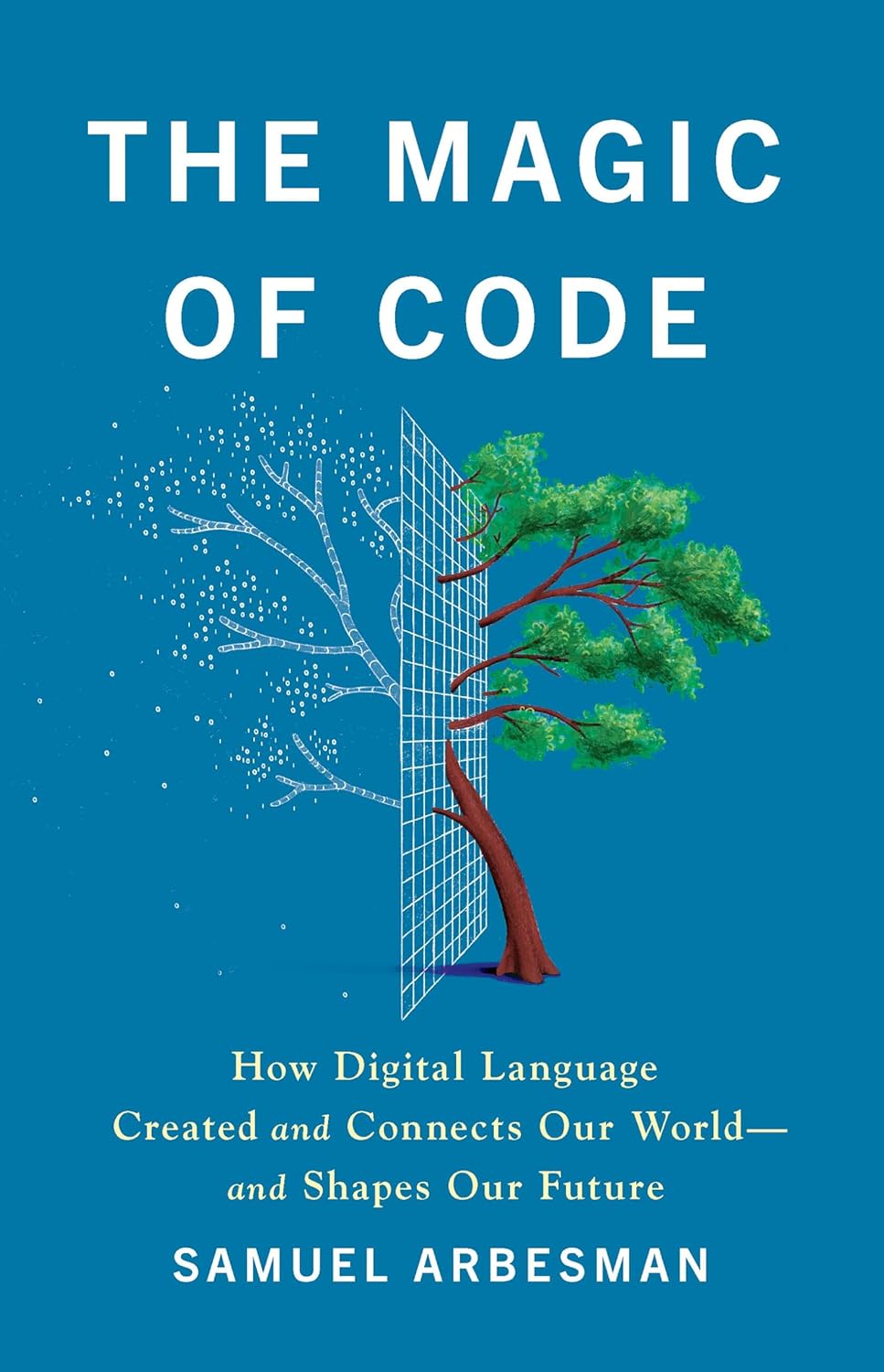Samuel Arbesman: The Magic of Code review - the spark ages | reviews, news & interviews
Samuel Arbesman: The Magic of Code review - the spark ages
Samuel Arbesman: The Magic of Code review - the spark ages
A wide-eyed take on our digital world can’t quite dispel the dangers

The slightly overwrought subtitle, "How Digital Language Created and Connects Our World and Shapes Our Future", gives a good indication how computer enthusiast Sam Arbesman treats his subject. Software, written in a variety of programming languages whose elements we refer to as code, is ubiquitous.
It underlies many parts of modern life, and current efforts look like extending its reach profoundly. And, while we can try to understand it by reading books like this, it’s not clear that we can influence it. Although it is made by humans, it is easy to get the impression (digital language shapes, connects, or even “created” our world) that code itself has agency.
Arbesman reckons that finding computers everywhere may mean we take them for granted, only noticing when they become objects of concern. He wants to reawaken a sense of wonder at computers, and at how we make them do our bidding. And he sees computing, and code, as a unifying influence, connecting “every other way of thinking and area of knowledge”.
 That’s a bold claim, and justifying it requires a very wide-ranging survey of how code is used. Software, he writes, consists of “spells of crystallised thought”. That description, I suppose, also fits a poem, a mathematical proof, or a symphonic score. But code is also thought that turns into action, of many kinds. Simple – often repetitive – operations inside the myriad logic gates of a computer chip can do, it feels, almost anything, from playing games to simulating an entire universe.
That’s a bold claim, and justifying it requires a very wide-ranging survey of how code is used. Software, he writes, consists of “spells of crystallised thought”. That description, I suppose, also fits a poem, a mathematical proof, or a symphonic score. But code is also thought that turns into action, of many kinds. Simple – often repetitive – operations inside the myriad logic gates of a computer chip can do, it feels, almost anything, from playing games to simulating an entire universe.
Toward the end, Arbesman gets to the possibility that we might even be living in just such a simulation (he is agnostic). That comes after a mostly engrossing series of short chapters on the nature of code, its similarity to magic as traditionally conceived, the properties of programming languages – the book’s second principal metaphor is the one the field took as its own – the way the use of spreadsheets made programmers of us all, and how software can enhance thinking, including the thinking needed for writing new code. Add a final part that covers computer modelling, applications of computational thinking in biology (and vice-versa) and it’s a truly ambitious agenda. Inevitably, coverage of some of these topics feels a tad superficial. The way we might try and understand the working of cells and tissues in computational terms, for instance, probably deserves a whole book.
Overall, too, this is a book of computer lore, rather than computer science. It presents lots of items gleaned from the now extensive literature on software (startling to be reminded that the influential text on software engineering, The Mythical Man-Month, is now fifty years old). These go along with reminiscences of the author’s own encounters with software and its results, some more relatable than others. Does being informed that McDonald’s website from 1996 was “adorable” because it had hand-drawn graphics and a childishly simple design reinforce the enchantment of computing if you didn’t actually use it at the time? Perhaps not. And while Arbesman avers that the book is aimed at non-programmers, they may still want to know how things actually get done. This non-programming reader would certainly have liked a little more explanation of some of the basics. Having a copy of a well-written lay introduction to the fundamentals would be handy – I recommend Daniel Hillis’ The Pattern on the Stone if you can get hold of it.
A limitation harder to avoid is that the current issues computers and their programmers pose are developing so fast that a quick summary soon feels outdated. That’s true of his discussions of the ways AI packages use training data, for instance. But Arbesman is more concerned with deriving some general principles about how to deal with computers and code, rather than offering prescriptions for particular problems. Yes, he concludes, let us celebrate all we can now do with computers. But also keep in mind that software is evanescent, like all other human creations. And remember, too, that reality is always more complex than the representations we build into our programs, so “we cannot fall prey to an unexamined view of our machines’ outputs.”
That’s on the penultimate page here, but again it feels like it could be the starting point for another whole book. Now he’s done his best to persuade us that the world of computing is full of wonders, I hope Arbesman gives us that other, more cautionary, volume.
The future of Arts Journalism
You can stop theartsdesk.com closing!
We urgently need financing to survive. Our fundraising drive has thus far raised £49,000 but we need to reach £100,000 or we will be forced to close. Please contribute here: https://gofund.me/c3f6033d
And if you can forward this information to anyone who might assist, we’d be grateful.

Subscribe to theartsdesk.com
Thank you for continuing to read our work on theartsdesk.com. For unlimited access to every article in its entirety, including our archive of more than 15,000 pieces, we're asking for £5 per month or £40 per year. We feel it's a very good deal, and hope you do too.
To take a subscription now simply click here.
And if you're looking for that extra gift for a friend or family member, why not treat them to a theartsdesk.com gift subscription?
more Books
 'We are bowled over!' Thank you for your messages of love and support
Much-appreciated words of commendation from readers and the cultural community
'We are bowled over!' Thank you for your messages of love and support
Much-appreciated words of commendation from readers and the cultural community
 Frances Wilson: Electric Spark - The Enigma of Muriel Spark review - the matter of fact
Frances Wilson employs her full artistic power to keep pace with Spark’s fantastic and fugitive life
Frances Wilson: Electric Spark - The Enigma of Muriel Spark review - the matter of fact
Frances Wilson employs her full artistic power to keep pace with Spark’s fantastic and fugitive life
 Elizabeth Alker: Everything We Do is Music review - Prokofiev goes pop
A compelling journey into a surprising musical kinship
Elizabeth Alker: Everything We Do is Music review - Prokofiev goes pop
A compelling journey into a surprising musical kinship
 Natalia Ginzburg: The City and the House review - a dying art
Dick Davis renders this analogue love-letter in polyphonic English
Natalia Ginzburg: The City and the House review - a dying art
Dick Davis renders this analogue love-letter in polyphonic English
 Tom Raworth: Cancer review - truthfulness
A 'lost' book reconfirms Raworth’s legacy as one of the great lyric poets
Tom Raworth: Cancer review - truthfulness
A 'lost' book reconfirms Raworth’s legacy as one of the great lyric poets
 Ian Leslie: John and Paul - A Love Story in Songs review - help!
Ian Leslie loses himself in amateur psychology, and fatally misreads The Beatles
Ian Leslie: John and Paul - A Love Story in Songs review - help!
Ian Leslie loses himself in amateur psychology, and fatally misreads The Beatles
 Samuel Arbesman: The Magic of Code review - the spark ages
A wide-eyed take on our digital world can’t quite dispel the dangers
Samuel Arbesman: The Magic of Code review - the spark ages
A wide-eyed take on our digital world can’t quite dispel the dangers
 Zsuzsanna Gahse: Mountainish review - seeking refuge
Notes on danger and dialogue in the shadow of the Swiss Alps
Zsuzsanna Gahse: Mountainish review - seeking refuge
Notes on danger and dialogue in the shadow of the Swiss Alps
 Patrick McGilligan: Woody Allen - A Travesty of a Mockery of a Sham review - New York stories
Fair-minded Woody Allen biography covers all bases
Patrick McGilligan: Woody Allen - A Travesty of a Mockery of a Sham review - New York stories
Fair-minded Woody Allen biography covers all bases
 Howard Amos: Russia Starts Here review - East meets West, via the Pskov region
A journalist looks beyond borders in this searching account of the Russian mind
Howard Amos: Russia Starts Here review - East meets West, via the Pskov region
A journalist looks beyond borders in this searching account of the Russian mind
 Henry Gee: The Decline and Fall of the Human Empire - Why Our Species is on the Edge of Extinction review - survival instincts
A science writer looks to the stars for a way to dodge our impending doom
Henry Gee: The Decline and Fall of the Human Empire - Why Our Species is on the Edge of Extinction review - survival instincts
A science writer looks to the stars for a way to dodge our impending doom
 Jonathan Buckley: One Boat review - a shore thing
Buckley’s 13th novel is a powerful reflection on intimacy and grief
Jonathan Buckley: One Boat review - a shore thing
Buckley’s 13th novel is a powerful reflection on intimacy and grief

Add comment